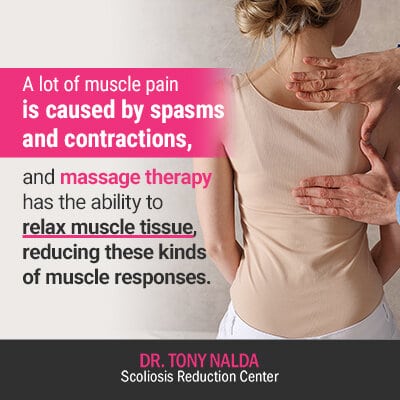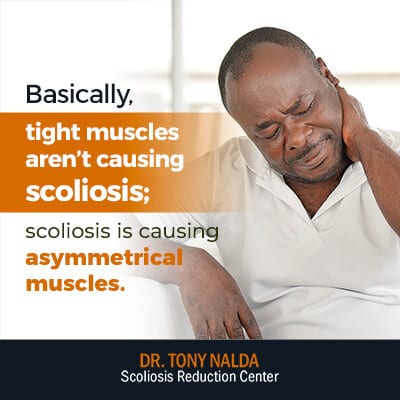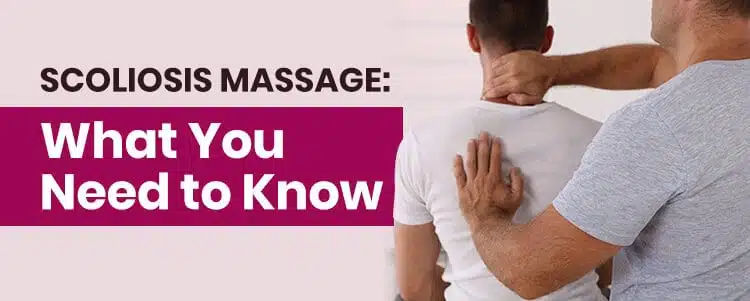When it comes to treating scoliosis, the distinction between treating the condition and treating symptoms of the condition can become blurred. While there’s no harm in using massage therapy to alleviate scoliosis-related pain and discomfort, patients should be aware that the results are temporary and won’t do anything to actually treat the condition.
Scoliosis is a complex condition, and while it primarily involves structural issues within the spine, the symptoms extend beyond the bones to the muscles and nerves. Scoliosis massage therapy, though not a cure for scoliosis, can serve as a valuable tool in managing some of these symptoms, particularly when integrated into a broader, comprehensive treatment plan. By targeting the muscle tightness and pain that often accompany scoliosis, massage can help alleviate discomfort and improve the quality of life for those living with the condition.
Moreover, massages promotes relaxation, reduces stress, and improves blood circulation, all of which can indirectly benefit scoliosis patients by enhancing overall well-being and supporting the body’s natural healing processes. However, it is important for patients to understand that while massage can provide temporary relief, it does not address the underlying spinal curvature that characterizes scoliosis.
Although the National Scoliosis Institute estimates that there are close to 7 million people currently living with scoliosis in the United States alone, there are still a lot of misconceptions about the condition. One such misconception is that scoliosis is a muscular issue and can therefore be treated with massage therapeutic treatment. For a better understanding of why this is not the case, let’s first take a look at how massage works.
Scoliosis Massage Therapy
I’m a big believer in the power of massage therapy, if it’s to address a muscular issue. Massage can actually produce physiological changes in the body through what’s known as the ‘relaxation response’ and related mechanical responses.
When considering massage therapy for scoliosis, aka a scoliosis massage, it’s essential to select the right type of massage to target the specific symptoms and muscle imbalances associated with the condition. Scoliosis massage therapy, for example, can help alleviate muscle pain and tension. Cranial sacral therapy, while not addressing the underlying cause of scoliosis, can provide temporary relief from pain and improve overall function by mobilizing restricted tissue around the spinal column. Deep tissue massage is effective in reaching the deeper layers of muscle tissue, which can help relieve chronic tension in the muscles surrounding the spine. This can be particularly beneficial for patients who often experience tightness and discomfort due to the uneven pull on their muscles. Regular massage therapy is important for scoliosis patients as it offers dual benefits of pain relief and relaxation, improving overall well-being by reducing muscle stiffness and alleviating discomfort.
Myofascial release is another technique that can be beneficial for patients. This type of massage focuses on releasing tension in the fascia, the connective tissue that surrounds muscles. By addressing fascial restrictions, myofascial release can improve flexibility and reduce pain. Neuromuscular therapy, which targets trigger points within the muscles, can also be effective in alleviating the localized pain that many patients experience. Each of these techniques offers distinct benefits, and a skilled therapist can tailor a treatment plan to meet the unique needs of scoliosis patients.
Relaxation Response
People tend to get massages for two main reasons: pain relief and relaxation. The relaxation response is how the nervous system automatically responds to touch during massage therapy.
When a person is getting a massage and is experiencing pain relief and relaxation as a result, their heart rate, breathing, and blood pressure slows down. The production of stress hormones like cortisol are also decreased, allowing the muscles to relax.
For someone with muscle stiffness and tightness, this relaxation response is a highly effective way to relax, loosen those tight muscles, and relieve discomfort.
Just as a massage and that relaxation response can decrease the levels of stress hormones in the body, it can also increase the levels of serotonin in the body, a chemical associated with positive emotion and thoughts.
Massage can also be a powerful resource for people who suffer from anxiety and need the benefit of relaxation and stress relief.
Mechanical Responses
Massage can also produce mechanical responses within the body when the muscle’s soft tissues are stimulated by the pressure applied during massage.
The physical manipulation of muscles during a massage can cause physical changes within the body, such as increasing blood circulation, and the relaxation and normalization of muscle, connective tissue, tendons, and ligaments; this can positively impact nerves and deeper connective tissue.
Through the physical manipulation of soft tissue and the release of chemicals through the relaxation response, blood circulation is improved. This improved circulation increases the delivery of nutrients and oxygen throughout the body and to the cells of muscles.
This improvement to cellular health means that muscle tissues experience functional improvement and helps reduce soft-tissue swelling.

Relaxing Muscle Tissue
A lot of muscle pain is caused by spasms and contractions, and massage therapy has the ability to relax muscle tissue, reducing these kinds of muscle responses.
When muscles are contracting, they are also compressing the nerves around them, causing pain and discomfort. When a massage relaxes muscles, the nerves are relieved of the compression that they experience when the muscle is contracting.
By relieving nerve compression, their ability to transmit signals and messages to and from the brain is increased, and this improves the overall functioning of the muscles.
All of these benefits make massage therapy a valuable resource for people needing help with relaxation and stress relief, or those suffering from muscle cramps, spasms, and tightness.
While these are worthy reasons to seek out massage therapy, when it comes to specific massage for scoliosis, at best, it will only produce the temporary result of pain relief during the massage, but those results won’t be carried out of the office with the patient; this is because the massage isn’t addressing the scoliosis itself, but only one symptom of it.
The feeling of relief that scoliosis patients might experience during a massage will quickly diminish after the massage is over because those contracted muscles will return. Those contracted muscles will return because their asymmetry is caused by the structural issue of scoliosis.
Scoliosis is a Structural Problem
If a person is diagnosed with scoliosis, this means they have a structural deformity of the spine. Their spine has an abnormal sideways bend that coincides with rotation, making it a 3-dimensional condition.
This is why I say massage therapy for scoliosis is ineffective because scoliosis is not a muscular issue, but a structural one within the spine itself.
While scoliosis massage treatment might help relieve some associated pain and discomfort, this is only addressing a symptom of the condition and is doing nothing to treat it.
When scoliosis is present, there is associated rigidity in the spine, and this causes it to twist and turn. This rigidity makes the spine very hard to move. In fact, the more severe a patient’s condition is, and generally the older a patient is, the more rigidity becomes an issue as the spine is that much harder to manipulate.
The rigidity of a scoliosis spine is also what contributes to the tightening of the surrounding muscles. While massage techniques for scoliosis might allow for some temporary relaxation and loosening of those muscles, when the massage is over, the relaxation effect is over as well, while the spine’s rigidity that’s causing the muscle tightness remains.
If a spine with scoliosis was easy to move, people would be able to bend out of the curve and reduce it on their own, but they can’t. If patients can’t use their own motion and momentum to bend out of the curve, rubbing the paraspinal muscles isn’t going to reduce the curve either.
Scoliosis and Muscle Asymmetry
When a person develops scoliosis, the natural healthy curves of the spine are lost and replaced by bad curves. These unhealthy curves cause the postural changes associated with scoliosis such as rib deformity, uneven hips, shoulders that don’t sit at the same height, and arms and legs that appear to be different lengths.

This asymmetry also affects muscle tone. If the asymmetry of the spine and the associated effects on the rest of the body didn’t include muscle tone, a person with scoliosis would literally fall down.
Basically, tight muscles aren’t causing scoliosis; scoliosis is causing asymmetrical muscles.
Massage therapy is effective on other conditions that are caused by muscle asymmetry, such as an injured or strained muscle. In these cases, a massage therapist can massage the affected muscle and produce a lasting response, but that’s because those are legitimate muscle issues.
In scoliosis, the muscles are reacting to the curve, and nothing else.
Even though I do believe that scoliosis and massage therapy have a connection in terms of temporary pain relief, this is only addressing one symptom of the condition. It’s important for patients to understand this distinction because no amount of massage therapy for scoliosis is going to be curative in nature or have any actual treatment results in the short or long term.
For those relying solely on massage therapy for scoliosis-related pain, they are going to be dependent upon getting massages all the time because no amount of massage is going to address the asymmetrical muscle tone causing the issue; the asymmetrical muscle tone is due to the asymmetrical spine.
It’s somewhat like having a car with more weight in the front and back corner; you won’t have shocks that are going to wear equally. You’re going to have stronger shocks in one spot and weaker ones in another so the car can stay balanced.
In much the same way, the human body is an amazingly resilient and adjustable system. Once an abnormal curvature develops, it’s quite impressive how the spine’s surrounding muscles, and the rest of the body, adjusts to the curve so mobility and balance can be maintained.
Can Getting Scoliosis Massage Therapy Actually be Harmful?
There was once a very interesting scoliosis study done when its cause was thought to be related to muscle tightness. The thought was that the muscles and muscle tone inside was too tight and that the asymmetry would cause a curve to develop.
They got a group of scoliosis patients and applied muscle stimulation on the outsides of their curves to try and tighten the weaker muscles, increasing muscle strength and straightening the asymmetry.
They used transcutaneous electrical nerve stimulation (TENS) to make these muscles more flacid and loose to allow for movement of the spine – at least, that’s what they thought it would do. The actual result was that every single curve progressed, and we now understand those results because we know the tight muscles are holding the spine, not causing it.
Theoretically, if massage could work at the level of muscle stimulation and TENS and actually alter the nerves, it could be harmful, but I don’t think that’s possible as the deep spinal musculature isn’t accessible through massage alone.
Again, in theory, if a massage therapist could reach that deep spinal musculature with the intensity of TENS, it could be contraindicated because the body’s trying to stabilize itself, and massage could be stopping that normal defence mechanism.
However, I don’t think massage therapy could be strong enough to cause that kind of harm, just as it’s not powerful enough to affect scoliosis pain on a structural level.
Myths about Scoliosis Massage
One common misconception is that massage therapy alone can ‘cure’ scoliosis. While it can alleviate pain and tension, it does not correct spinal curvature. Another myth is that all types of massage are beneficial for scoliosis, whereas some techniques may not be suitable and could even exacerbate symptoms. Always consult with a specialist to determine the best approach for your specific condition.
Conclusion
Ultimately, to call scoliosis massage an effective form of treatment is somewhat of a misnomer. It works only for temporary pain relief, not for achieving any actual structural change, which is what has to occur to achieve a reduction and treat the condition.
In terms of treating the tight muscles and pain associated with scoliosis temporarily, some patients enjoy going for massage therapy; where it can get dangerous is if someone is under the impression that massage therapy alone has the power to reduce their scoliosis.
If someone is under this misconception and relying on it to treat their condition, it’s likely that their curvature is being left to progress unimpeded. This means the condition is progressing in severity, the spine’s becoming more rigid, and the condition’s becoming more difficult to treat.
Here at the Scoliosis Reduction Center®, when we reduce a curve in our patients, that process involves very little muscular work, but what happens naturally through a structural reduction of the curvature is those associated muscles relax on their own.
What I will say is this: while scoliosis massage doesn’t have a place in producing actual treatment results, as long as patients fully understand this, if they find it helpful in terms of stress relief or temporary pain management, this is unlikely to cause any harm.
When it comes to scoliosis treatment, there is no quick and easy fix. In order to reduce a structural deformity of the spine, a proactive treatment approach capable of producing a structural change, in the form of a reduction, is the only way to permanently alleviate pain and produce lasting results.




